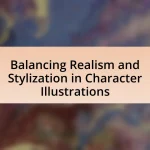Backstory is a fundamental aspect of character design, providing essential depth and motivation that shape characters’ behaviors and interactions within narratives. It influences character development by offering context for motivations, relationships, and emotional responses, making characters more relatable and believable. The article explores how backstory enhances storytelling, impacts plot progression, and fosters emotional connections with the audience. It also discusses the key components of effective backstory, the challenges in creating it, and best practices for ensuring alignment with character arcs, ultimately emphasizing the significance of backstory in crafting compelling narratives.

What is the Importance of Backstory in Character Design?
Backstory is crucial in character design as it provides depth and motivation, shaping how characters behave and interact within a narrative. A well-developed backstory informs the character’s personality, goals, and conflicts, making them relatable and believable to the audience. For instance, characters with rich histories often exhibit more complex emotions and decisions, enhancing the overall storytelling experience. Research in narrative psychology indicates that audiences engage more deeply with characters who have clear motivations rooted in their past, leading to a more immersive experience.
Why is backstory crucial for character development?
Backstory is crucial for character development because it provides context that shapes a character’s motivations, behaviors, and relationships. Understanding a character’s past allows writers to create more nuanced and relatable characters, as it explains their current actions and decisions. For instance, a character who experienced trauma may react differently to conflict than one who had a supportive upbringing. This depth enhances storytelling by making characters more believable and engaging, ultimately leading to a richer narrative experience.
How does backstory influence a character’s motivations?
Backstory significantly influences a character’s motivations by providing context for their desires and actions. A character’s past experiences, relationships, and traumas shape their worldview and decision-making processes. For instance, a character who faced abandonment in childhood may seek validation and connection in their adult relationships, driving them to act in ways that reflect their need for security. This connection between backstory and motivation is supported by narrative theory, which posits that understanding a character’s history allows audiences to comprehend their current behavior and choices more deeply.
What role does backstory play in shaping character relationships?
Backstory plays a crucial role in shaping character relationships by providing context and depth to interactions. It informs characters’ motivations, fears, and desires, which directly influence how they relate to one another. For instance, a character with a traumatic past may approach relationships with distrust, affecting their ability to connect with others. This dynamic is evident in literature and film, where characters’ histories often dictate their responses and alliances, creating tension or camaraderie. The significance of backstory is supported by narrative theory, which emphasizes that understanding a character’s background enhances audience engagement and emotional investment in their relationships.
How does backstory enhance storytelling?
Backstory enhances storytelling by providing depth and context to characters, which fosters emotional connections with the audience. When characters have well-developed backstories, their motivations, fears, and desires become clearer, allowing readers or viewers to understand their actions and decisions more profoundly. For instance, a character who has experienced loss may react differently to conflict than one who has not, making their journey more relatable and engaging. This depth is supported by narrative theory, which emphasizes that characters with rich histories are more compelling and believable, ultimately leading to a more immersive storytelling experience.
What impact does backstory have on plot progression?
Backstory significantly impacts plot progression by providing context and motivation for characters’ actions. This context shapes character development, influencing decisions that drive the narrative forward. For example, a character with a traumatic past may react differently to conflict than one without such experiences, creating tension and depth in the storyline. Additionally, backstory can introduce subplots that enrich the main narrative, as seen in works like “The Great Gatsby,” where Gatsby’s past informs his present ambitions and relationships, ultimately affecting the plot’s trajectory.
How can backstory create emotional connections with the audience?
Backstory creates emotional connections with the audience by providing context and depth to characters, allowing viewers to understand their motivations and struggles. When audiences learn about a character’s past experiences, such as trauma, loss, or triumph, they can empathize with the character’s current actions and decisions. Research indicates that narratives with rich backstories enhance emotional engagement; for instance, a study published in the Journal of Personality and Social Psychology found that individuals are more likely to form attachments to characters with relatable histories. This connection fosters a sense of investment in the character’s journey, making the audience more emotionally responsive to their challenges and growth.

What elements contribute to an effective backstory?
An effective backstory is primarily shaped by character motivation, conflict, and transformation. Character motivation provides the driving force behind a character’s actions and decisions, establishing a clear purpose that resonates with the audience. Conflict introduces challenges that the character must navigate, creating tension and engagement in the narrative. Transformation illustrates the character’s growth or change over time, making their journey relatable and impactful. These elements work together to create a rich, compelling backstory that enhances character depth and audience connection.
What are the key components of a character’s backstory?
The key components of a character’s backstory include their origin, significant life events, relationships, motivations, and conflicts. Origin refers to the character’s background, such as where they were born and raised, which shapes their identity. Significant life events encompass pivotal moments that influence their personality and choices, such as trauma or achievements. Relationships highlight connections with family, friends, or mentors that impact their development. Motivations reveal what drives the character, whether it be ambition, love, or revenge. Conflicts illustrate internal or external struggles that the character faces, adding depth to their narrative. These components collectively create a comprehensive understanding of the character, enhancing their relatability and complexity in storytelling.
How do personal history and experiences shape a character?
Personal history and experiences significantly shape a character by influencing their motivations, behaviors, and emotional responses. A character’s backstory, which includes their upbringing, relationships, and pivotal life events, provides context for their actions and decisions. For instance, a character who faced adversity in childhood may develop resilience or distrust, affecting their interactions with others. Research by McAdams (2001) in “The Stories We Live By” highlights that individuals construct their identities through narratives formed by their experiences, demonstrating that a well-developed backstory is essential for creating believable and relatable characters.
What significance do cultural and social backgrounds hold in backstory?
Cultural and social backgrounds are crucial in backstory as they shape a character’s identity, motivations, and behaviors. These backgrounds provide context that influences how characters interact with their environment and other characters, making them more relatable and believable. For instance, a character raised in a collectivist culture may prioritize community over individual desires, while one from an individualistic background may focus on personal achievement. This distinction can be observed in various narratives, where characters’ decisions and conflicts often stem from their cultural and social experiences, thereby enriching the story and enhancing audience engagement.
How can backstory be integrated into character design?
Backstory can be integrated into character design by informing visual elements, personality traits, and motivations. For instance, a character’s past experiences can dictate their clothing style, scars, or accessories, which visually represent their history. Additionally, a character’s backstory can shape their behavioral patterns and emotional responses, making them more relatable and complex. Research indicates that characters with well-defined backstories engage audiences more effectively, as they provide context that enhances storytelling and character development.
What techniques can writers use to reveal backstory organically?
Writers can reveal backstory organically through techniques such as dialogue, character actions, and sensory details. Dialogue allows characters to share their past experiences naturally during conversations, providing context without explicit exposition. For instance, a character might mention a childhood event while discussing a current situation, subtly informing the reader of their background. Character actions can also hint at backstory; for example, a character’s reaction to a specific location may indicate a traumatic experience associated with it. Sensory details, such as smells or sounds, can evoke memories, allowing readers to infer backstory through the character’s emotional responses. These techniques are effective because they integrate backstory into the narrative flow, making it feel seamless and engaging for the reader.
How does visual design reflect a character’s backstory?
Visual design reflects a character’s backstory by incorporating elements such as color, clothing, and physical features that symbolize their history and experiences. For instance, a character with a rugged appearance and worn clothing may indicate a life of hardship or survival, while bright colors and elegant attire might suggest a privileged upbringing. These visual cues serve as immediate indicators of a character’s past, allowing audiences to infer their motivations and personality traits without explicit exposition. Research in character design emphasizes that visual elements can evoke emotional responses and convey complex narratives, reinforcing the connection between design and backstory.

What challenges arise when creating backstory for characters?
Creating backstory for characters presents several challenges, including maintaining consistency, avoiding excessive complexity, and ensuring relevance to the main narrative. Consistency is crucial because a character’s backstory must align with their actions and development throughout the story; inconsistencies can confuse the audience and undermine character credibility. Excessive complexity can overwhelm both the writer and the audience, making it difficult to convey essential traits and motivations clearly. Additionally, the backstory must be relevant to the plot; irrelevant details can detract from the main storyline and dilute character impact. These challenges highlight the need for careful planning and integration of backstory within the overall character arc.
What common pitfalls should be avoided in backstory creation?
Common pitfalls to avoid in backstory creation include excessive detail, which can overwhelm the audience and detract from the main narrative. Additionally, creating backstories that are disconnected from the character’s current motivations can lead to inconsistencies in character development. Another pitfall is relying on clichés or stereotypes, which can make characters feel one-dimensional and unoriginal. Lastly, neglecting to integrate the backstory into the character’s actions and decisions can result in a lack of depth and relatability. These pitfalls can undermine the effectiveness of the backstory in enhancing character design and engagement with the audience.
How can excessive backstory detract from character development?
Excessive backstory can detract from character development by overwhelming the narrative and hindering character progression. When a character’s history is overly detailed, it can shift focus away from their current actions and motivations, making them less relatable and dynamic. For instance, if a character’s backstory includes extensive details about their childhood, it may lead to a slower pacing in the story, causing readers to lose interest in the character’s present journey. This phenomenon is supported by narrative theory, which suggests that character development thrives on conflict and change rather than static histories. Therefore, a balance must be struck to ensure that backstory enhances rather than overshadows character growth.
What strategies can be employed to maintain balance in backstory?
To maintain balance in backstory, writers should employ strategies such as selective detail inclusion, pacing, and relevance to the main narrative. Selective detail inclusion involves providing only essential backstory elements that directly influence character motivations or plot developments, ensuring that extraneous information does not overwhelm the reader. Pacing is crucial; backstory should be revealed gradually throughout the narrative rather than in large, infodump sections, allowing for a more engaging and digestible experience. Relevance to the main narrative ensures that every piece of backstory serves a purpose, enhancing character depth without detracting from the story’s progression. These strategies help create a cohesive and engaging character design that resonates with the audience.
How can feedback improve backstory effectiveness?
Feedback can improve backstory effectiveness by providing insights into how well the narrative resonates with the audience. When creators receive constructive criticism, they can identify gaps in character motivation, emotional depth, or plot coherence, which are essential for a compelling backstory. For instance, studies in narrative psychology indicate that well-developed backstories enhance character relatability and engagement, leading to a more immersive experience for the audience. By incorporating feedback, writers can refine their characters’ histories, ensuring that the backstory aligns with the overall narrative and enhances the character’s role within the story.
What role does audience feedback play in refining backstory?
Audience feedback plays a crucial role in refining backstory by providing insights into how characters and narratives resonate with viewers. This feedback allows creators to identify which elements of the backstory are engaging or confusing, enabling them to make informed adjustments. For instance, studies have shown that audience reactions can highlight inconsistencies or gaps in character motivations, prompting writers to enhance depth and coherence. By analyzing audience responses, creators can ensure that the backstory aligns with the overall narrative and enhances character development, ultimately leading to a more compelling story.
How can collaboration with other creators enhance backstory depth?
Collaboration with other creators can significantly enhance backstory depth by integrating diverse perspectives and ideas. When multiple creators contribute, they bring unique experiences and insights that can lead to richer character histories and more complex narratives. For instance, a writer collaborating with an artist can visualize a character’s emotional journey, while a musician can influence the character’s mood and tone through sound. This multifaceted approach allows for a more nuanced exploration of themes and motivations, ultimately resulting in a more compelling backstory. Research in collaborative creativity indicates that diverse teams produce more innovative outcomes, as seen in studies by the Harvard Business Review, which highlight how varied viewpoints foster creativity and depth in storytelling.
What are best practices for crafting compelling character backstories?
To craft compelling character backstories, focus on creating depth through personal history, motivations, and conflicts. A well-developed backstory should include significant life events that shape the character’s beliefs and actions, such as formative experiences, relationships, and traumas. Incorporating specific details, like cultural background or pivotal moments, enhances relatability and authenticity. For instance, a character who overcame adversity may exhibit resilience, making them more engaging. Additionally, ensuring that the backstory aligns with the character’s current goals and challenges creates coherence in their narrative arc. This approach is supported by narrative theory, which emphasizes the importance of character development in storytelling, as seen in works like “The Writer’s Journey” by Christopher Vogler, where character arcs are linked to their backstories.
How can writers ensure backstory aligns with character arcs?
Writers can ensure backstory aligns with character arcs by developing a cohesive narrative that reflects the character’s motivations, conflicts, and growth throughout the story. This alignment can be achieved by identifying key events in the character’s past that directly influence their current decisions and relationships. For instance, if a character’s backstory includes a traumatic event, this can shape their behavior and choices, creating a logical progression in their character arc. Additionally, writers should regularly revisit the character’s backstory during the writing process to ensure that it remains relevant and supportive of the character’s development. This method is supported by narrative theory, which emphasizes the importance of character consistency and development in storytelling.
What tips can help in creating relatable and engaging backstories?
To create relatable and engaging backstories, focus on developing characters with realistic motivations and experiences. Characters should have clear goals, fears, and flaws that resonate with the audience, making them more relatable. Incorporating universal themes such as love, loss, or redemption can enhance engagement, as these themes are widely understood and felt. Additionally, grounding the backstory in specific details, such as cultural background or personal history, adds depth and authenticity. Research indicates that well-rounded characters with relatable struggles lead to greater audience investment, as seen in successful narratives across literature and film.


